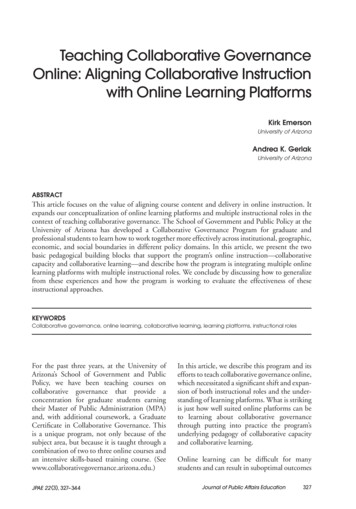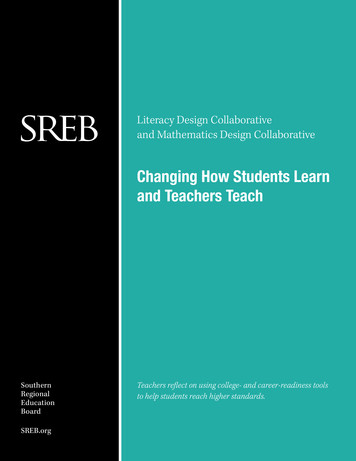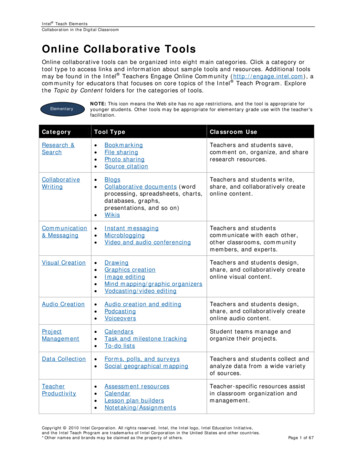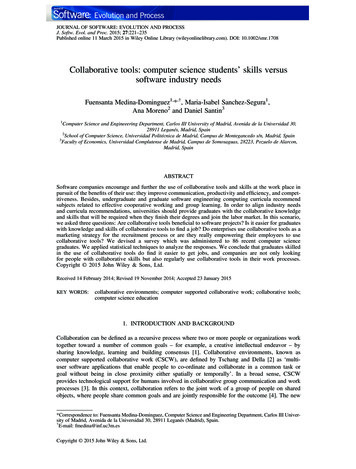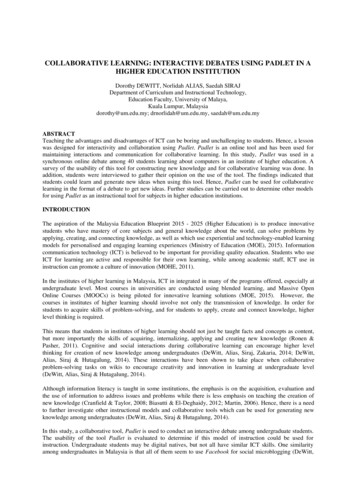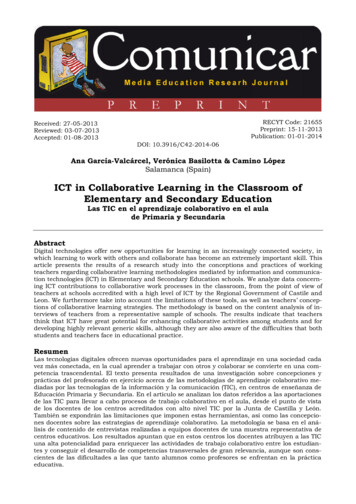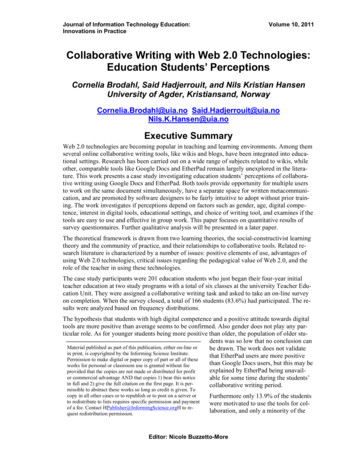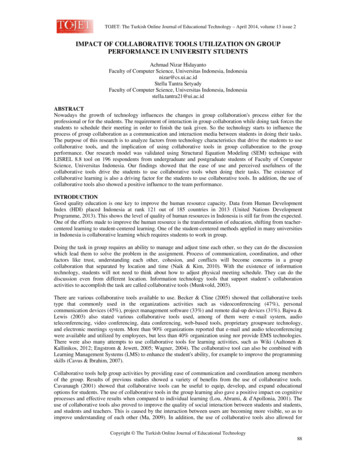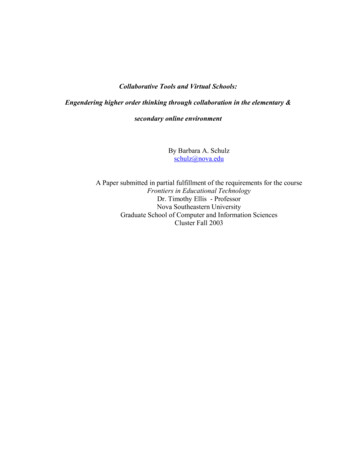
Transcription
Collaborative Tools and Virtual Schools:Engendering higher order thinking through collaboration in the elementary &secondary online environmentBy Barbara A. Schulzschulz@nova.eduA Paper submitted in partial fulfillment of the requirements for the courseFrontiers in Educational TechnologyDr. Timothy Ellis - ProfessorNova Southeastern UniversityGraduate School of Computer and Information SciencesCluster Fall 2003
Table of FiguresPage . 3Abstract . 5I.Introduction: Education joins the CyberWave. 6II. Overview of K12 online learning: A. Overview of Primary and SecondaryOnline Learning . 6III. Literature review on emerging online collaboration tools. 11IV. Application of the tools in Virtual Schools . 19V. Conclusions and suggestions for future research. 20Reference List: . 23Resources . 25
3Table of FiguresPageFigure 1 Tapped In's User Interface. 15Figure 2 Kidlink's KidSpace Interface. 16Figure 3 Moodle's Interface . 16Figure 4 3DWriter interface. 18
4
5AbstractAs the cyberwave of online learning reaches primary and secondary schools,educators will need tools to ride this wave. Online learning has made great headway inhigher education, and research has been done extensively at that level. Much of theresearch points to the benefits of collaboration online enhancing the development ofhigher level thinking skills (Gokhale, 1995). With the extensive growth of primary andsecondary online schools over the last eight years, educators need to be able to utilizetools that will encourage that collaboration and the development of higher level thinkingskills in this new environment. This paper will give an overview of emerging onlinecollaboration tools and an analysis of their use and application in K-12 Virtual Schools.
6I.Introduction: Education joins the CyberWaveAs education rounds the corner of the millennium and heads down the straight wayfor future generations, medical, political, and technological changes are causing a majorshift in how education is delivered to students. As high stakes testing pressures causeparents to examine the success of their schools closely, and since the No Child LeftBehind legislation gives parents more choices, virtual schools have become a viablealternative for primary and secondary students. Russo (2001) states that virtual schoolscould solve such problems as teacher shortages, limited course offerings, dropouts, andthe need for individualized learning. The individualized curriculum provided makesvirtual schools a prime vehicle in this paradigm shift. These vehicles, while still in thevisionary stage, are starting to become a reality, and their final appearance is currentlybeing shaped.This chapter will explore some technological tools that may shape virtual schools.Particular focus will be on emerging tools that aid in collaboration and the developmentof higher order thinking skills, as well as preventing the problem of social isolationmentioned by Russo (2001).II. Overview of K12 online learning:A. Overview of Primary and Secondary Online LearningFrom the debut of The Virtual High School in 1996, funded by a five-year grantin Hudson, Massachusetts (Hammonds, 1998), to the doubling of enrollment in onlinecourses between 2001 and 2002 (Taylor, 2002), the history of online learning in primaryand secondary schools has been very brief, but is currently experiencing a meteoric rise.
7The slow grass roots movement included only 30 online schools across the nationin the year 2000 with only five percent of educators being aware of online programs(Russo 2001). According to the Center on Education Policy (Fulton, 2002) between 4050,000 primary and secondary students enrolled in an online course in the 2001/2002school year. In addition, 28 percent of leaders surveyed by National School BoardsFoundation believe that one out of every five students will receive a part of theirinstruction over the Internet in the next three years. In addition, Kalmon (2002) points outthat 90 percent of American children and teenagers currently use the Internet.From the students who take online courses in a lab in their district school, tohome school students, or students who need a special challenge, a wide range of studentsoccupies this new environment. Students in the original Virtual High School were highschool students with schedule challenges or students who needed to take a special coursefrom a teacher at a distance. Current students range from primary students attendingfrom home, to advanced placement students who take college courses while in highschool. In addition, state funding has encouraged more students to jump on boardincluding those who found challenges in the regular classroom, whether these challengeswere academic or socially grounded. The current political climate influenced by the NoChild Left Behind Act, allowing students in “failing” schools to choose their school, hasgiven states the latitude to fund computers and internet connections for virtual students,which also adds to the variety of students in the environment.The types of online environments vary as much as the mixture of students. Thedelivery of online courses can take place by teleconferencing in a TV lab set up just forthis purpose, in a computer lab, or the comfort of home. Hammonds (1998) pointed out
8that some schools combine motion video with music and sound, while maintaining ahumanistic environment. Although in the beginning virtual schools utilized theteleconferencing set up, this use has been limited due to heavy price tags, as well as theexpertise needed to run the equipment. The limitations of teleconferencing need to betaken into account but should not rule out teleconference labs as useful tools. The nextdevelopmental step taken by the virtual schools was the establishment of online coursesin the local school offering students alternative courses. The original arrangementinvolved the district school having one teacher from the cooperating school teach onlinecourses for every twenty students enrolled from that school in online classes. This setupgave students more variety and flexibility, yet kept them under the guidance of their localschool system. More recently, the mandates of the No Child Left Behind (NCLB) Acthave given parents and schools even more alternatives. School systems are applying theirper pupil expenditure to develop charter or alternative schools with an online provider(Eng, 2003). The online provider supplies the curriculum, while the local schoolsupplies a computer and Internet access for the student, as well as paying teachers toteach in this environment. These environments can be based in the student’s home or in alocal school lab. Parents who have a job allowing them to work from home, as well ashome school parents, are the most frequent users of this type of school environment. Inaddition, parents who have students who had challenges in public school, whether thechallenges were social, mental, religious, or physical, take advantage of this environmentto give their children the benefit of one-on-one attention and assistance. With thisvariety of types of environments, a question is raised about the curriculum being studiedby the students, and the teaching or learning strategies being applied.
9The curriculum can consist of hands-on lessons presented by a parent in the home,a student following a multimedia lesson on the computer, or individually paced lessonsfollowed by immediate feedback after a lesson with an online assessment. Teachingstrategies can include systematic presentation of materials via online text or multimediafiles, collaborative projects, or independent study. Hammonds (1998) pointed out thatsome online students utilize inquiry learning while creating, designing and working inteams, but have to adapt to higher stimulation and a faster pace. Thomas (2002)summarized that individual courses taught at state schools have certified teachers whileonline charter-schools depend on parents to help to monitor student instruction.Barriers and IssuesThe limitations of online learning include technical challenges, lower-thanaverage completion rates, equity issues, lack of evaluative data, and objections fromteachers' unions. Technical limitations include email challenges due to an unresponsivepartner, or the challenges of working with partners across time zones. Technicalrequirements for providing rich and interactive online content can sometimes exceed thecurrent technical capacities provided by districts. This lack of technical capacity limitsthe ability of districts to provide equitably for all students, no matter how muchtechnology is available in the home or district.The list of negatives against virtual schools can include the prohibitive time andmoney needed for teacher training and developing courses. Teachers’ unions worry aboutthe amount of time teachers will need to teach online.Cifuentes, (2001) added that another limitation comes from the student’s sense ofdetachment to other students as well as to the instructor. This will become an especially
10important issue in the primary and secondary virtual schools due to the nurturing thatneeds to occur at that level, as well as the need to learn collaboration skills.The lack of evaluative data on the successes and failures of virtual schools shouldcause educators to proceed slowly in accepting this method of delivering instruction. Theloss of accountability due to some students not showing up to take state tests have causedsome educators to be concerned about this medium. In addition, the belief that somedistricts were using online programs to recoup revenue losses from declining attendance,adds to the political unrest on this issue.B. Overview of Research on Collaborative Online LearningThe growth of virtual primary and secondary schools has been so fast, thatresearch results are still in process, with publications reaching the press on a regularbasis. Much of the previous research has centered on online learning in higher education(Porter, 2002; Taylor, 2002; Thomas, 2002). Many researchers point out the benefits ofonline learning as including anytime, anyplace learning (Abramson, 2000), authenticlanguage learning (Cifuentes, 2001), active and just-in-time learning (Dringus, 2000),"vicarious learning", or observing another student's learning experience and relating it totheir own (MacDonald, 2001). Confirming Russo’s (2001) comments on social isolation,the Center on Education Policy (Fulton, 2002) states that one of the many topics needingresearch is on the type and quality of social interactions taking place in virtual schools.Collaboration online would be a viable way to increase social interactions.Research in the face-to-face classroom has studied collaboration as a teachingstrategy extensively, and research on online learning confirms the validity of its use inthat environment. Dringus (2000) stated that creating a sense of presence in any
11educational setting has an essential need to promote communication with peers. Gokhale(1995) pointed out that group interaction makes students’ scholarship, skills, andexperiences beneficial to others in the group because students had to validate theiropinions by giving reasons for decisions, and reflecting on the criteria behind thejudgments. Lotan (2002) further stated that by giving “group-worthy tasks”, teachers givetheir students’ opinions and views a sense of legitimacy in the eyes of their peers. Incontrast, Jackson’s (2000) study showed no direct evidence that "collaboration withinimmersive virtual environments aided the process of conceptual change”, however,evidence was shown of the possibilities of conceptual change occurring due to dealingwith conflict, expressing opinions, and collaborating on theories.Kaplan (2002) gave suggestions for improving the community feeling in onlinelearning. These suggestions included clearly defining the roles of each group member bydetailing the responsibilities of each. A second suggestion was to create an individualprofile for each member of the group. Lastly suggested was to set guidelines for onlineand offline etiquette, and successful group behaviors for reaching learning outcomes.The emerging technological tools available to encourage or enhance collaborationonline are of great interest to educators since collaboration is strongly supported as ameans to decrease social isolation in virtual schools and encourage higher-level thinking.III. Literature review on emerging online collaboration toolsSince the days of FredNet, before the dawn of the World Wide Web, teachershave been interested in developing online collaborative activities for their students. Mostearly collaboration online took place using a text based gopher and listservs or email.These activities usually wore the guise of online projects, and involved communication
12across countries with e-pals or experts in a field. Some examples of the projects andhistory can be seen at the I*EARN (http://www.iearn.org/projects/index.html) andKidlink (http://www.kidlink.org/KIDPROJ/) websites. However, since thecommunication depended on the technological expertise of the teachers involved, as wellas being extremely time consuming, relatively few classrooms participated in theseprojects. As the Internet exploded in the mid 1990’s, publishers and other entitiesbecame involved in developing such projects as Scholastic’s Global altrek/index.htm) or Global SchoolhouseNetwork’s (http://www.gsn.org) Project Registry. These projects involved a largeinvestment of time and revenue. While these projects became popular with teachers,wide spread use of the projects were prohibited due to the technological limitations ofhaving only one computer in the classroom, or the unavailability of the school lab. Sincethe late 1990’s with the federal investment in e-rate funding, and the commitment ofgetting all schools connected, the technological challenges have diminished, but thepressure for high stakes testing has simultaneously drained the energy of districts andteachers, thus still limiting participation in online collaboration. At the turn of thecentury, with the No Child Left Behind legislation, schools and districts are trying to findalternative ways to meet the needs of students. One of these alternative methods hasbeen the development of virtual online schools. In the beginning, high school studentsprimarily utilized the virtual schools by accessing online courses developed by teachersin the Virtual High School (Hammonds, 1998). Once again, vendors joined the causecreating curriculums for virtual schools. Most of these programs, however, whilecreating curriculums that encourage individual learning by students, are not clear about
13involving the students in collaborative activities. This has caused virtual schools tobecome a focus of state and federal agencies (Carr, 2001; Kalmon, 2002; Thomas, 2002;USDE, 2002), which have developed a national vision and recommendations for virtualschools. The national vision highlighted the need for “Social cohesion and sharedculture” (USDE, 2002). But how can virtual schools meet this principle? Rather thanbeing limited to the business world, technological advances have progressed and theeducational arena is finally applying them. While most of the advances are happeningwith online training for businesses, they can be adapted to fit the educational mold.Gordon’s (2003) “List of Collaboration ts1.htm) gives a solid alphabetical list ofonline conferencing and meeting software utilized in the business and trainingenvironment, which could be adapted for use with virtual students. Most of these toolsinclude presentation software, online videos, chatting, and file-sharing capabilities, whichare the basics needed for any online collaborative learning to occur. However, Barnett(2002) contends that while online videos aid in learning, videos lack interactivity, so thepresence of the teacher gives depth to the learning process. An additional tool that may beincluded in some of the above mentioned tools is the whiteboard, which Kahn (1994)claims is the most important of these tools as it allows participants to write, type, anddraw on a shared drawing window as well as scrolling back to earlier versions of thecontents to show growth. While Kahn was discussing synchronous collaboration,Isenhour (2000) supported asynchronous collaborative authoring, stating that centralizedrepositories for shared documents needed to be included. Isenhour (2000) also indicated
14that scheduling challenges cause erratic interaction patterns thus reinforcing the need forsmooth transitions between synchronous and asynchronous modes of collaboration.With the need to adapt these business solutions to the educational environment,Portugal (2000) suggests using metaphors in the development of virtual environments.For example, the designation of virtual places such as halls, collaboration rooms, offices,and so on, would ease the student into the virtual school. Yehezkel (2002) takes thiseasement one step further with the “InCA information system” which would keep trackof the user preferences and goals. A user model would utilize diagnostic agents to collectand analyze information submitted by users. Then learner's needs would determine theinterface in which the information is presented, and learning activities complete withintervention strategies matched to the student’s needs .Some of these adaptations have become reality in tools like Tapped In, Moodle,3DWriter, and KidSpace, which are discussed in detail below:Tapped In is the most versatile tool, and best meets the needs mentioned by Portugal(2000) of a user interface that uses metaphors for its layout. It utilizes a virtual campusfor an international community of education professionals. Primary and secondaryteachers and librarians, as well as other education professionals attend “After SchoolOnline” (ASO) training workshops and discussions. The package has a separate campusfor primary and secondary students, and allows teachers to set up locked office spacesthat allow only their students inside for virtual chats and discussions. The layout includesthe metaphors of rooms, buildings, and passageways for navigation. The ability to droppapers into the office for viewing by others encourages an online discussion about a pieceof work (See figure 1 for details). It allows synchronous and asynchronous
15communication, and automatically drops a copy of transcripts into a participant’s emailbox for follow up later. While designed for adult users, this environment has already hada student version added to it, and could be easily adapted for use in primary andsecondary virtual classrooms.Figure 1 Tapped In's User InterfaceKidlink’s KidSpace is an old program reinvigorated and adapted to meet the modernneeds of students. While Kidlink was utilized for online projects throughout the 1990’s,its developers have kept up with the technological advances by adding a new interface tothe program. The old online projects still exist and many are still active today, but
16submitting student work and commenting on the work of others has become much easierfor participants. The addition of a discussion board and a voting tool, adds moreversatility to an already strong interactive program.KidSpace interface for creating web pages to add to anKidSpace interface for commenting on the work of otheronline collaborative project.students.Figure 2 Kidlink's KidSpace InterfaceMoodle (Dougimas, 2003) is a tool that can be utilized to set up and conduct onlinecourses, and has been designed to be compatible with any computer platform. The tool isopen source so available to any teacher that has the time to learn how to use it. Thesoftware gets set up using the teacher's own computer as a server, which gives totalcontrol to the teacher. The software uses a modular layout, and has shared libraries,abstractions, and cascading style sheets, which can be linked to other services such asmail servers, or student directories. While this program may take some time to learn, itputs the development of online courses in financial range for educators.
17Figure 3 Moodle Interface3DWriter - While this package is NOT a collaboration tool in itself, it is a reasonablypriced software package, which enables students to create web pages from a textdocument. It will essentially allow virtual students to easily share their work with peersvia a web page without having to learn HTML editing. However, the creators do not givepointers about how to get the pages created onto the web, nor do they suggest how tocollaborate in the writing. The virtual teacher would need to have students submit thepages to be placed on a class web site. The fact that the pages are transformed to HTMLwill ease the burden on the teacher.
18Figure 4 3DWriter interfaceVirtual reality, simulations and holograms are additional tools that have a highpotential for use with virtual students. Sykes (1999) states that students must becomemore involved in their studies in virtual worlds because the headsets limit distractionsfrom learning. As students immerse themselves into their virtual worlds or simulations,teachers become facilitators in student's self-discoveries. Patterson (2001) adds that theuse of VRML (Virtual Reality Modeling Language) makes interactive 3D worlds a viablepossibility for use in the near future by a student using a dial up connection. In addition,Layng (1995) advises that the use of Hologram technology to give students 3D training insuch fields as mechanical and medical studies, is on the horizon. The merging of virtualreality, holograms, and artificial intelligence will create new virtual worlds in the not toodistant future that will open many new possibilities. With the addition of the above-
19mentioned collaborative tools, the look and feel of the educational virtual environmentwill morph before our eyes!IV. Application of the tools in Virtual SchoolsWhile the vision of online learning morphs to its future, how can educatorsharness this mutation to aid students? Salmon (2000) describes 5 steps to successfulonline learning – access, motivation, dissemination of knowledge by an instructor withthe students showing evidence of learning, knowledge construction, and using sharedknowledge to create something new. Virtual schools have the access, students aremotivated, and the dissemination of knowledge is presently occurring. With the first threesteps already occurring in virtual schools, the addition of collaborative learning to theenvironment will put virtual schools well on their way to becoming successful learningenvironments.The literature is full of references to activities that can make the virtual schoolcurriculum a powerful experience for students. Sykes (1999) gives examples of studentstaking virtual reality trips back in time to experience the War of 1812, visit the ancientruins of Mayan Chichen Itza, or virtually be present at the writing of the Constitution in1787. For scientific experiences, a student can be virtually set adrift around the sun tounderstand the solar system, or explore inside a virtual cell to find out about diseases.McLester (2001) suggested that remote controlled microscopes could allow learners tosee the tile of a space shuttle up close, or the bone of an ancient creature. Indeed, manysuch learning experiences that are realities today, such as Global Schoolhouse’s(www.gsn.org) Field Trips, Geo Game, and CyberFair (Angehm, 2001) or Multi User
20Virtual Environments (MUVE) such as the Bike Rally by National Science Foundation(Crystal, 2001) could be utilized in the virtual school environment.The addition of asynchronous chat can scaffold that rich learning, and the learningexperience can expand and deepen by following several threads at once (Bober, 2001).Sharing the rich learning experiences through discussion, and MacDonald’s (2001)“vicarious learning", or observing another student's learning experience and relating it totheir own, will serve to move the students to Salmon’s (2000) fourth step of knowledgeconstruction in online learning. Utilizing such interfaces as Tapped In, 3DWriter andKidSpace will help students move to Salmon’s fifth step of using shared knowledge tocreate something new for an authentic audience (Rea, 1999) thus developing their higherorder thinking skills.V. Conclusions and suggestions for future researchAs the visions for virtual schools morph through the next decade, educators needto be sure that this new environment is meeting the needs of students. With all theresearch pointing to collaboration as a strong point in the online educational process, theuse of collaboration tools should become part of that vision. The directive from theCenter on Education Policy (Fulton, 2002) to develop “Social Cohesion and sharedculture”, should be a strong incentive for virtual schools to be sure that they includecollaboration as a learning strategy. Students using virtual environments will be enteringthe same work force as “brick and mortar” students, and will still have the same need forskills such as collaboration with peers, and thinking skills to be able to solve problems.
21The few tools evaluated here are just the tip of the iceberg of what is available asevidenced by Gordon’s (2003) “List of Collaboration Tools” being utilized now inbusinesses. Each of those applications have the potential to be adapted to the virtualschool environment if vendors can find a way to lower the price tags or find additionalfunding for schools.In addition, the development of virtual reality, holograms and artificialintelligence as teaching tools needs to be observed closely as those fields mature, and areapplied in academic settings, as their potential for use in virtual schools is powerful.However, as educators examine these tools before applying them in the virtualschool environment, several directions for research become apparent. The researchquestions to consider are:1.Is the collaboration proven necessary in higher education onlinelearning, as necessary in primary and secondary virtual schools?2.What assistive adaptations are needed to enable virtual students withphysical handicaps to collaborate online?3.Does collaboration truly increase higher level thinking skills in virtualprimary and secondary school students? Will the research done at thehigher education level be consistent when applied to K-12 students?4.Does collaboration decrease the risks of social isolation for primary andsecondary virtual education students?5.Does collaboration improve cultural awareness in primary andsecondary virtual education students?
226.How does the role of the online teacher effect the virtual student’slearning competency?These questions are just a few of the many topics which will shape the vehiclewhich the primary and secondary virtual schools will become as future students ridethrough this cyberwave of educational change.
23Reference List:Abramson, G. E., Ellis, T. (2000). Defining a Distant Environment for TeacherEducation. Paper presented at the Society for Information Technology & TeacherEducation International Conference: San Diego, CA.Angehm, A., Nabeth, T. & Roda, C. (2001). Towards personalised, socially aware andactive e-learning systems. Retrieved November 15, 2003 from EBSCO.Barnett, M., Harwood, W., Keating, T., & Saam, J. (2002). Using emerging technologiesto help bridge the gap between university theory and classroom practice:Challenges and successes. School Science & Mathematics, 102(6). 299-313.Bober, M. J. D., V.P. (2001). Intersubjectivity: Facilitating knowledge construction inonline environments. Retrieved November 17, 2003, 2003, fromhttp://www.tandf.co.uk/journalsCarr, S. (2001). Governors' Association Seeks Expansion of Distance Education.Chronicle of Higher Education, Vol. 47(43,), pA31, 31/34p.Cifuentes, L. S., Yu-Chih Doris. (2001). Teaching and Learning Online: A CollaborativeBetween U.S. and Taiwanese Students. Journal of Research on Computing inEducation, Summer 2001; 33(4), 456.Crystal, J. (2001). Simulations. Technology & Learning.Dougimas, M., & Taylor, P. (2003). Moodle:Using learning communities to create anopen source course management system. Paper presented at the EDMedia 2003,Honolulu, Hawaii.Dringus, L. P. (2000). Towards active online learning: a dramatic shift in perspective forlearners. The Internet and Higher Education, 2, 189-195.Eng, P. (2003). Virtual School Daze: Online tech offers new choices in education.Retrieved 9/16/2003, 2003, virtualschools030916.htmlFulton, K., & Kober, N. (2002). Preserving principles of public education in an onlineworld: What policymakers should be asking about virtual schools. Paperpresented at th
Collaborative Tools and Virtual Schools: Engendering higher order thinking through collaboration in the elementary & secondary online environment By Barbara A. Schulz schulz@nova.edu A Paper submitted in partial fulfillment of the requirements for the course Frontiers in Educational Technology Dr. Timothy Ellis - Professor
